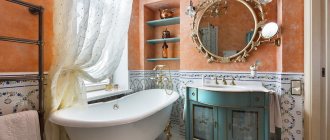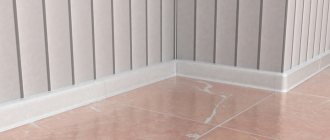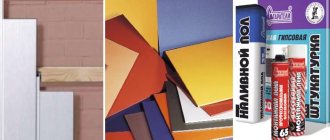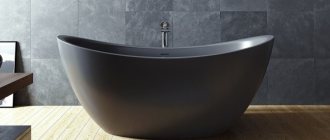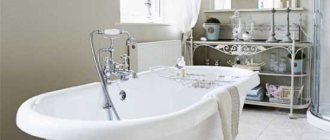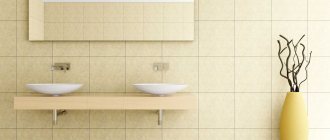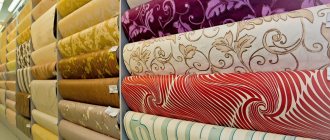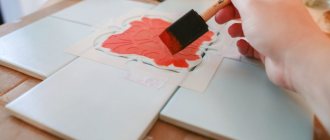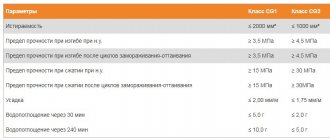The interiors of apartments, houses, offices, public institutions and premises are not complete without the use of mirrors, which not only perform their usual function, but are also placed as a decorative element. A mirror can radically change the appearance of any space, visually expanding it. Mirror mosaic creates bright highlights and unusual effects; it can be used in the bathroom or kitchen as a backsplash. In addition, elements with a reflective surface and glass parts are used when decorating furniture and accessories. A special atmosphere is created by stained glass made from multi-colored pieces.
Mirrors that do not have frames or special fasteners, mosaic mirrors, are fixed directly to the wall using a special glue suitable for most types of materials and textures. Mirror glue is produced by domestic and foreign companies, whose products have a wide range.
This glue creates a strong elastic layer between the mirror and the wall, thereby maintaining the integrity of the back side and the surface as a whole. Even if the mirror breaks or cracks over time, its fragments will not fall or scatter, but will remain attached to the layer. This method of fixation is suitable for objects of light weight and medium size.
Requirements for glue for mirrors
When choosing a suitable product, even a high-quality one from a well-known brand, you should make sure that the composition is intended not just for glass, but specifically for mirrors. The fact is that some of them may contain components that destroy the amalgam (reflective layer), which over time will lead to the appearance of stains on the mirror surface. Also, the fastening composition should not contain acids or alkalis.
You should not use universal glue for mirrors, as it can also ruin the amalgam. This is due to the fact that manufacturers, in an effort to reduce cost, add chemicals to it that harm reflective surfaces.
When choosing, the material of manufacture and the specifics of the room in which the mirror will be located are no less important. Since the dimensions of the glass change with temperature changes, an adhesive should be used for bathtubs and showers that not only withstands high humidity, but is also not afraid of cold and heat. If it is not flexible enough, a hard substrate will form on the surface after drying, which may result in the glass cracking. Accordingly, the mirror will hold securely only if the adhesive composition has good elasticity and adhesion.
Adhesive types fall into two categories: neoprene and acrylic, each with its own properties. Neoprene contains rubber, so it has a strong odor but good adhesion. Acrylic is environmentally friendly, but cannot be used everywhere. Water solubility makes it undesirable to use in rooms with high humidity, such as the bathroom and kitchen.
Requirements for high-quality glue for mirrors:
- No toxic substances, alkalis or acids in the composition.
- High level of adhesion to various materials.
- Light or transparent color.
- Fast drying time.
- Elasticity.
Using an adhesive with the wrong composition may cause undesirable consequences. At best, these will be dull spots on the surface, at worst, the mirror may simply fall.
The cheapest option is solvent-based glue. Silicone is chemically neutral and provides good adhesion. But their drying time is slightly longer. Therefore, it is easiest to work with a fastening agent that has a hybrid composition. Its high cost is more than compensated by a high-quality connection.
The glue should be intended not just for glass, but specifically for mirrors
The glue must be resistant to changes in temperature and humidity
Choosing glue for the bathroom
A practical choice for a room with high humidity would be Penosil Premium Mirrorfix adhesive-sealant. This professional product is made on the basis of synthetic rubber. It should be used for mirror surfaces up to 6 mm thick. Penosil is also perfect for gluing mirror mosaics. The sealant dries quickly enough, but allows time for minor adjustments - the glue hardens in 10-15 minutes.
The advantages of Penosil adhesive-sealant are:
- resistance to moisture, the product provides excellent adhesion and does not collapse when in a humid environment;
- after hardening, the base becomes strong and elastic;
- the glue dries quickly and does not deform under the influence of UV radiation;
- The surface dries after application after 15 minutes.
Another product that has proven itself well when working in a damp environment is SOUDAL 47A glue. This glue for mirrors, like the first product (Penosil), is made on the basis of synthetic rubber. It is important to use it not only for gluing mirrors in the bathroom, but also mirror mosaics, ceramics and foam plastic. The main feature of SOUDAL 47A is its water resistance, as well as excellent grip on different surfaces. However, it is worth remembering that the glue contains solvents.
Popular adhesives
The main criterion when choosing glue is the presence of high adhesion. Many well-proven compounds are suitable for it, for example, silicone sealant. Non-standard solutions are also possible; as an option, you can glue the mirror to liquid nails. A composition intended for aquariums is also suitable for the bathroom. Among all the variety, Titan and Abro products are especially popular.
Titan
Used to work with different surfaces: concrete, metal, tiles, brick, paint, wood, drywall. Reliability is ensured by the organic resins and synthetic rubber included in the composition. Main advantages:
- high adhesion;
- water resistance;
- elasticity;
- strength;
- amalgam preservation;
- ease of use.
Titan is applied to a surface from which grease has previously been removed. The distance between the glue strips is 5 cm. They retreat 2 cm from each edge. If after gluing the position of the mirror is not satisfactory, it can be corrected within a few minutes.
Abro
Strong adhesive for mirrors with increased adhesion. The basis is epoxy resin. Used for joining various materials with glass. It can be used for gluing the glass itself, which plays an important role when it is necessary to fix a broken piece. When completely dry, it remains transparent. There are no yellowish streaks left. When used in the bathroom, moisture does not spoil the quality of the seams.
It is sold in a set consisting of two ampoules. One of them contains the adhesive itself, and the other an activator. Before starting work with ampoules, cut off the spouts, squeeze their contents into a container and mix thoroughly. Use a syringe to draw up the adhesive and cover the surfaces to be glued with it.
Loctite
Composition of two components: glue and activator. The contents of the package are enough for one or two mirrors, depending on the dimensions. Before application, the parts are mixed and applied to the amalgam in an even layer. Advantages: quick drying, color retention, no smudges. The product is also available in aerosol form, which makes the task easier. High efficiency is combined with economical consumption.
Permatex
It is used mainly for car mirrors, but the properties of the composition allow it to be used in everyday life. It is highly resistant to temperature changes, making it suitable for the bathroom. Available in a tube. It appears to be a clear liquid. The base is cyanoacrylate resin, which provides high adhesion and rapid hardening. The composition does not contain solvents. The advantage is that the glue consists of one component, so there is no need to mix it, which saves time.
DoneDeal
Silicone based sealant. Has a wide range of applications. Often used for gluing mirror tiles and other decorative elements. When applied to the surface it forms a uniform coating. It is heat resistant. Elasticity and strength guarantee high reliability. Advantages: good adhesive properties, transparent color, moisture resistance, long service life, ease of use, low price. Among the disadvantages is that it cannot withstand heavy loads, so it is not suitable for massive mirrors.
Popular manufacturers
Soudal 47A – manufacturer Belgium. This wall mirror adhesive contains synthetic rubber and resins. It is characterized by high strength, moisture resistance, hardens quickly and does not damage the mirror. Works well with many surfaces, suitable for baths.
Chemically neutral silicone adhesive-sealant for mirrors and mirror walls.
“Bison Mirror Adhesive” (Holland) is a neutral silicone designed for fixing small mirrors on any surface. Provides strong fastening, heat-resistant, moisture-resistant, acid-free.
Strong elastic adhesive for gluing mirrors.
Soudal Mir-o-Bond is a silicone-based adhesive-sealant. Can be used for gluing mirrors to smooth and uneven surfaces. Reliably fixes the object on almost all surfaces, heat resistance from -40 to +150 degrees, sets in 30 minutes, has no pungent odor.
Acrylic assembly adhesive for interior and exterior work.
"Tegra Point" (Poland) - rubber-based liquid nails. Designed for attaching all types of mirrors, mosaics, ceramics to almost all surfaces. It is characterized by high quality adhesive layer, elasticity, heat resistance, good adhesion and easy to use.
Liquid Nails for mirrors.
Modern adhesive bases are a safe, fast, convenient and reliable way to mount a mirror on any wall in the bathroom, hallway or any other room. There is no need for special tools or expensive installation materials. You do not need extensive experience in repair or finishing work.
What is auxiliary fastener
Before you start attaching a mirror to the wall, especially if it is large, you should think about how to hold it until it dries completely. In this case, various types of auxiliary fasteners will come to the rescue. When gluing small mirrors, you can use lighter types of fasteners rather than the adhesive itself. The most popular types include liquid nails and double-sided tape. Each method has its own scope of application depending on the material.
The advantage of liquid nails over other methods is that they create a strong connection, even if the parts to be glued do not fit tightly together, which is especially important for porous materials. This greatly simplifies the installation of uneven surfaces. The base is synthetic rubber with polymer additives. The big advantage is elasticity.
Before gluing a mirror with liquid nails, you will need to purchase a special gun into which a cartridge loaded with glue is inserted. Outwardly, it resembles a syringe. By pressing, the adhesive composition is applied to the degreased surface in a dotted or serpentine manner. The use of liquid nails for a mirror is advisable when the reflector is to be glued to wallpaper or drywall.
An alternative to this method is double-sided tape. It is a tape with an adhesive applied to both sides. On one side it is protected by a film. It can only withstand light, small-sized canvases. Pieces of tape are evenly distributed over the fat-free back surface. Then the protective film is removed from them and pressed against the material. This way you can glue the mirror to a cabinet or any other furniture. The method is suitable for beginners, since if there are any unevenness, the tape can be easily removed and re-glued.
Liquid Nails
Double-sided tape
Universal glue
As a rule, versatility is not a positive characteristic for building materials. Professionals prefer specialized compounds. However, this rule does not apply to Moment Montazh glue. This quick-drying and moisture-resistant product is ideal for use in any room, even the bathroom. “Moment Installation” provides reliable adhesion to various surfaces. Great for sticking mirrors to concrete, wood, plaster, metal and other painted surfaces. The product contains synthetic resin.
The main advantages of the Moment Montazh brand:
- the product does not damage the mirror surface;
- It is important to use glue in a humid environment: the base does not collapse under the influence of moisture;
- the sticky base is quite strong, flexible and not fragile;
- The product is reliable in use and copes well with high and low temperatures;
- open operating time - 20 minutes;
- dries completely within 7 days.
Bonding technology
The algorithm of actions depends on the type of material on which the mirror can be glued. The surfaces on which the composition will be applied must first be degreased. The use of glue on the back side is possible not only in stripes, but also in dots. When fixing a large mirror, you should prepare supports. When working, it is necessary to observe safety measures: provide access to fresh air, use personal protective equipment, hold the can or tube of glue in such a way as to prevent contact with the eyes. In addition, you should make sure that the product has not expired.
To the furniture
In order to save space, mirrors are often fixed on furniture, it can be wood, plywood, chipboard, MDF. Before gluing the mirror to the wood, all surfaces should be degreased with a solvent. What glue can be used for these purposes is specially designed or colorless construction silicone.
When choosing how to glue mirrors to plywood and similar materials, you should rely on the weight and size of the reflector. For a small, lightweight product, you can use liquid nails, but for a massive one, it is better to take a more reliable composition. What else you should pay attention to is the condition of the surface - if it is not covered with varnish or a laminating compound, it must be sanded with sandpaper and degreased.
If you are going to stick a mirror on a cabinet door, the latter should first be removed from its hinges. Then attach the product to it and outline it around the perimeter. After degreasing, stick double-sided tape on the door in strips of small width at a distance of 10-20 cm, depending on the width. Apply glue between the strips. After the composition has dried, the door can be placed back on the cabinet.
Check dimensions
There should not be a gap between the mirror and the door
Degrease the surfaces of the elements
Apply glue
Glue the mirror
To Wall
It’s not difficult to choose wall adhesive for a mirror. The industry produces different types that allow you to attach the reflector to metal or concrete. But what you can use to glue a mirror to walls whose surface is covered with wallpaper is mounting adhesive. However, it is worth considering: if the mirror weighs more than two kilograms, there is a possibility that the wallpaper will not withstand the load and will slide off along with the glue.
The concrete wall should be pre-coated with a primer, removing any unevenness. If you plan to attach a large mirror, first apply glue to the surface of the wall and distribute it evenly with a notched trowel. If it is painted, it does not matter what glue you use to plant the product. The main thing is to degrease the surface well and walk over it with sandpaper.
Before gluing the mirror, it is worth creating the optimal temperature in the room - from 10 to 30 ° C. The lower its value, the longer it will take for the glue to harden.
Prepare the mirror
Apply glue dots
Attach the mirror to the wall and support it
Secure the mirror with light pressure along the entire perimeter
Features of mounting mirrors on different surfaces
Regardless of what material you plan to glue the mirror to, the surface should be prepared. Tiles, painted walls and tiles are cleaned of dust and dirt and degreased. The concrete (cement) base is leveled with putty and primed. Untreated wood is impregnated with special compounds so that the porous wood absorbs less glue.
The preparatory stage of all work is the same. But there are some features of gluing to different materials.
Glass
Sometimes it becomes necessary to fix the glass to an equally fragile base. The structure will hold firmly if you adhere to certain rules.
Instructions on how to glue a mirror onto a mirror:
- The glue is applied in a continuous seam along the perimeter 2 cm from the edge of the product and in long strips in the form of a lattice on the inner plane.
- The new canvas is applied to the old mirror and gently pressed.
- The side seams are treated with transparent sealant after the glue has completely dried.
If you glue mirrors with edges, for example, in order to increase the area of the reflective structure, the composition should be applied to the back side of the glass and the joined edges. After this, the canvases are glued to the right place, and their location is adjusted if necessary. For delicate work, the compositions Titan, Abro, Loctite are suitable.
Wallpaper
You cannot glue mirror products directly onto wallpaper, since the weight of the accessory will cause the canvas to come off and the glass to fall. There are two options for gluing a mirror to wallpaper:
- Make a backing from plywood or fiberboard, fix the glass on it with rubber glue. It must be applied in vertical stripes in increments of 10 cm or pointwise, moving 2-3 cm from the edge. The underlay is attached to the wall mechanically (hinges, self-tapping screws, screws, dowels).
- Clear the installation area of wallpaper. After this, the concrete wall should be primed. Apply glue to the mirror and base and let it dry for 15 minutes. Repeat the procedure, and then carefully attach the structure to the wall and support it. They can be removed after the glue has dried.
Non-standard shapes of mirrors look original in any interior
The disadvantages of both methods are mechanical damage to decorative canvases. You will either have to remove the wallpaper from the place where the glass is installed, or drill holes in the wall to attach the plywood. But there is no other way to attach a mirror to a wall with wallpaper, since gluing paper (vinyl, non-woven fabric) with an amalgam coating will not form a strong enough layer that can withstand the weight of the glass.
Wooden surfaces
Mirrors are often used to decorate furniture. In order not to spoil the wooden base with holes for fasteners, the reflective sheet is glued rather than screwed. To fix the accessory on the cabinet door, it must be carefully removed.
Procedure for gluing a mirror to wood:
- Place the sash on a flat horizontal plane.
- Apply markings by placing a mirror on the door.
- Degrease the surface with solvent.
- Turn the mirror face down and wipe it clean.
- Apply silicone adhesive to the amalgam using a zigzag motion using a gun.
- Glue the glass onto the cabinet door, carefully aligning it with the markings.
- Check the accuracy of the location and adjust.
- Place objects that press the canvas tightly, for example, books.
After 24 hours, the silicone will firmly adhere to the cabinet door, and it can be installed on furniture.
It’s also a good idea to use double-sided tape, glue the glass onto the chipboard using liquid nails, and for a more durable connection, glue the mirror to the cabinet using adhesive tape and glue at the same time. Accessories are installed on plywood and natural wood in a similar way.
Drywall
If the product weighs no more than 20 kg, you can glue the mirror to drywall using liquid nails or double-sided tape. Adhesive tape is applied around the perimeter of the glass and crosswise on the back side. After this, remove the protective coating from the tape and press it tightly to the drywall.
When carrying out work in the bathroom, you need to use a special moisture-resistant tape.
If the installation is carried out using liquid nails, you need to apply the composition at a distance of a couple of centimeters from the edge of the glass. After gluing the mirror to the plasterboard wall, a support is installed under the canvas so that the accessory does not move out.
Models that weigh more than 20 kg cannot be glued. They can only be installed on fasteners - “butterfly”, “umbrella”, “Hartmut” plasterboard dowels.
Ceramic tiles or tiles
To glue a mirror onto tiles or ceramics in the bathroom, you need to:
- Degrease the work area with a solution of soda, alcohol, and solvent.
- Apply a continuous strip of glue along the perimeter of the glass on the back side, moving away from the edges.
- Coat the surface of the mirror with adhesive in the form of a grid or lattice.
- Attach the bathroom mirror to the tile, pressing it firmly against the surface.
- Install a support from below that holds the accessory until the glue dries.
In rooms with high humidity and constant temperature changes, only moisture-resistant compounds can be used for installation work.
The resulting gap between the mirror and the wall must be filled with transparent or white sealant. Seams can be sealed after complete polymerization of the adhesive (the manufacturer indicates the curing time of the composition on the packaging). When gluing the canvas to the wall in the bathroom, you need to remember that you need to adjust its position immediately - after 5 minutes the substance firmly adheres to the ceramic tiles or tiles.
Painted surfaces
The painted base needs to be cleaned. It will not be possible to glue a mirror to a painted surface due to the low adhesion of adhesives to paints and varnishes. To attach a product without a frame to the wall, you must:
- Prepare the base by removing paint from it.
- To improve adhesion, treat the area under the canvas with a primer.
- Apply glue to the amalgam and attach the mirror to the wall according to the markings made.
- Install lower supports to prevent the glass from sliding.
Another way is to use double-sided tape with liquid nails. Suitable for mounting small, lightweight objects on painted walls.
PVC and plastic
To mount a heavy mirror on a PVC panel, you cannot do without a wooden backing or frame. The plastic is fragile, susceptible to chemical compounds, and will not withstand a large mirror.
You need to prepare a base of wooden blocks, fix a compact mirror (1-2 kg) on it, and then fix it mechanically - install it on a wall covered with PVC panels. But a more reliable way is to make a hole in the plastic trim, drill the wall, and then attach the accessory to it.
Small mirrors can be glued using silicone, PVA glue, liquid nails in combination with double-sided tape.
To the tile
Similar to the previous methods, before starting the process, you should clean the surface of the tile from debris. For degreasing, use alcohol, acetone or white spirit. This should be done in several stages, each time waiting for it to dry.
Some problem is the difference in height between adjacent tiles, which can lead to the mirror being skewed and not fitting tightly. To avoid this, you should level the surface by applying a layer of plaster to it. Before gluing the mirror to the wall in the bathroom, it is recommended to apply a sealant.
If the mirror has a large area, it is necessary to install a supporting base.
How to choose the right glue for a mirror
Adhesive mounting adhesive allows you to stably and securely mount the mirror without damaging the bottom layer. It is resistant to moisture and temperature changes, which is excellent for the bathroom. Silicone cures quickly, is durable, reliable, colorless and is used for sealing contours.
It is impossible to clearly determine which one will be better. They stabilize the glass panel, retain its strength for a long time, despite exposure to moisture and temperature conditions, and also provide protection to the wall.
Adhesive mounting adhesive allows you to mount the mirror stably and securely.
When choosing, you should take into account the type of surfaces to be glued and, based on their composition, select adhesive solutions. If you need to mount a small canvas, you should pay attention to Tytan glue - a specialized product that is made on the basis of rubber and resins and ensures reliable adhesion. It is used for concrete, brick, plasterboard and wood. Waterproof, elastic and does not damage the surface of the mirror.
Waterproof, quick-drying mounting adhesive for mirrors and glass structures.
For large mirror surfaces it is better to use Quelyd Mastifix. It contains synthetic rubber and solvent. It is simply ideal for working with plastic, ceramics, metal, concrete, masonry and stone. Allows you to glue the mirror to the wall in damp rooms such as a bathroom; it does not lose its properties at temperatures from -20 to +90 degrees. It will help smooth out unevenness up to 5 mm and sets quickly.
Neoprene mounting adhesive QUELYD Mastifix for mirrors
How to glue two mirrors
The need to glue two surfaces together arises when an old mirror that has lost its appearance cannot be removed. To complete the task as efficiently as possible, you need to apply a suitable composition around the perimeter of both parts and press them against each other. After complete drying, treat the end gaps with sealant.
Before gluing mirrors with edges, you should take into account that connecting the side edges requires maximum precision and accuracy. The end side of an already hanging product must first be cleaned of dirt and dust. You should not remove the mirror, since during subsequent installation the small bonding area may not be able to withstand it and may burst.
To seal a fragile mirror surface, it is important to take into account the weight and dimensions of the product, the material to which it will be attached, and the temperature in the room. Bonding will be reliable only if you choose a high-quality composition and act strictly according to the instructions.
Apply double-sided tape to one of the mirrors, remove the protective tape and connect the products
Special cases
The rules for installing mirrors differ, due to the characteristics of the wall material. For example, any mirrors can be glued to a concrete base, but the cement surface should be carefully primed. When installing accessories on drywall, it is better to use a mechanical fastening method. And if you first make an intermediate screen (substrate), you can glue the mirror sheet to any wall.
Large mirror
Large glass products are more difficult to glue due to their large area and weight. Soudal brand adhesives have strong fixing properties. The product can be applied pointwise, but it is better to use a notched spatula to evenly distribute the composition and securely glue the mirror.
If the reflective surface occupies a very large area, you need to glue several canvases, leaving a technological gap of 2-3 mm between them, and installing supports at the joints.
It is advisable to immediately apply anti-splinter film to the glass.
How to remove glue from a mirror
During installation, excess adhesive may remain on the glass. It is easy to remove using products such as alcohol-containing compounds, gasoline combined in equal proportions with ethyl acetate, or window cleaners. Old stains should be thoroughly moistened and left for 2-3 hours to soften the glue. After this, just rub the stain with a sponge and rinse with warm water and detergent.
To avoid scratching the surface, do not use substances with abrasive particles, use hard objects or metal brushes.
How to stick a mount to a mirror
If the gluing method is not suitable in a particular situation, metal fasteners must be glued to the mirror accessory. The materials can be firmly connected with two-component epoxy glue, high-temperature silicone, Moment-Crystal.
Moment Crystal is used to firmly connect various materials
Contacting surfaces must be degreased with acetone, alcohol, or nail polish remover. The glass needs to be heated with a hairdryer to a temperature of +30°C, apply glue pointwise, press the metal fragment to the product and leave until completely dry. Installation of the mount is required if the mirror can only be fixed to the wall mechanically.
